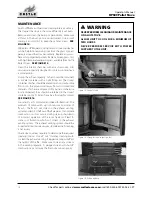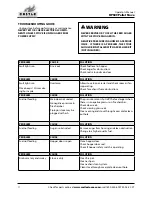
Operator's Manual
HPS09 Pellet Stove
Check for parts online at
www.castlestoves.com
or call 800-345-6007 M-F 8-5 CST
13
venting
consult vent manufacturer’s specifications and
recommendations for all venting installations.
The following installation guidelines must be followed to
ensure conformity with both the safety listing of this stove
and to local building codes.
Note: where passage through a wall, or partition
of combustible construction is desired, the instal-
lation shall conform to caN/csa -8365.
tyPe of vent
The pellet venting pipe (also known as L vent) is
constructed of two layers with air space between the
layers. This air space acts as an insulator and reduces
outside surface temperature of pipe to allow a clearance
to combustibles.
A UL listed 3” or 4” type L pellet vent exhaust system must
be used for installation and attached to the pipe connector
provided on the back of the stove. Use a 3” to 4” adapter
for 4” pipe. A cap must be used at the termination of type
L vent chimneys. For elevations above 2,500 feet above
sea level, a 4” L is required.
Pellet vent installation
Termination
must
exhaust above air inlet elevation.
It is recommended to install at least 3’ of vertical pellet vent
pipe. This vertical pipe will create some natural draft to
prevent the possibility of smoke or odor during appliance
shutdown.
The installation must include a clean out tee to enable
collection of fly ash and to permit periodic cleaning of
the exhaust system.
Total length of horizontal vent must not exceed 10 feet.
The maximum recommended vertical venting height is 18
feet. All joints for pellet vent are required to be fastened
with at least three screws and all pellet vent connections
must be sealed according to the vent manufacturer’s
recommendations.
The area where the vent pipe goes through to the exterior
of the home must be sealed with silicone or other means
to maintain the vapor barrier between the exterior and
the interior of the home.
Warning
do not connect this unit to a chimney
flue serving another aPPliance.
do not install a flue damPer in the
exhauSt ventIng SyStem of thIS unIt.
do not connect directly to a masonry
chimney.
do not terminate vent in any enclosed or
semi-enclosed area, such as; carPorts,
garage, attic, crawl sPace, under a sun
deck or Porch, narrow walkway or
closed area, or any location that can
build uP a concentration of fumes such
as a stairwell, covered breezeway etc.
Caution
vent surfaces can get hot enough to
cause burns if touched. noncombustible
shielding or guards may be required.
Pellet vent must maintain minimum
c l e a r a n c e s s P e c i f i e d b y v e n t
manufacturer for clearance to any
combustibles.
install vent at clearances sPecified by
the vent manufacturer.
all venting, whether vertical or
horizontal, joints should be made gas-
tight with recommended sealants.










































